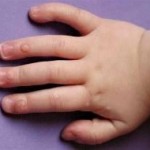Different Types of Warts on Children
 Small fleshy growths that many of us have had on some parts of the body are called warts. Usually they are no cause for concern and even may disappear on their own. However, if they are on the face or other exposed parts of the body you may want to get them removed. They are more common in children than in adults.
Small fleshy growths that many of us have had on some parts of the body are called warts. Usually they are no cause for concern and even may disappear on their own. However, if they are on the face or other exposed parts of the body you may want to get them removed. They are more common in children than in adults.
Types of body warts on children
- Most common variety is a small, hard dome shaped wart. It is brown or greyish brown in color. It resembles the head of a cauliflower and has some black dots on it. The surface is rough. The parts of the body where it is found are hands, fingers, elbows and knees.
- Warts growing on the bottom of the feet are called plantar warts. For obvious reasons they make walking an uncomfortable process.
- Very small warts which are smooth and have flat tops are called flat warts. They may appear in clusters. Children get them usually on their faces but they can appear on arms, hands and knees. Their color varies from yellow to pink and light brown.
- Warts shaped like fingers of the hand are called filiform warts. They grow on or around the mouth, nose or eyes.
Besides these warts, these can be found in the genital area. The virus causing them is sexually transmitted.
What causes warts in children ?
Parents have a question in mind that, why does my child keeps getting warts repeatedly?. Basically, warts are caused by viruses belonging to the family of human papillomavirus or HPV. They are skin infections which may be formed on any part of the body. If there are scratches or cuts on fingers, hands or feet, the virus enters the body from there. They thrive in a warm and moist place and multiply. Children who bite their finger nails or try to dig out hang nails create exposed open areas for the virus to enter and form a wart. When children touch a towel or something a person with a wart has used, or a bath mat used by an affected person, then they pick up the infection and get warts.
Children don’t necessarily get warts by touching one but infection is passed on when a person with a wart touches or uses something like towels, clothing and then another child uses the same object. Close physical contact also encourages spread of infection. If a child has a small cut or broken skin or if the wart is picked, the infection can spread to other parts of the body. Once the virus enters the body, a wart may take a long time to grow. The time elapsed varies but it may take many weeks to appear.
Getting rid of warts
Warts are generally painless and don’t require any treatment. Some warts disappear between six months to a year. However, if it causes discomfort, then a doctor will remove it. He will first try over the counter or prescription medicines which are to be applied locally. Other methods are cryosurgery in which the wart is frozen with liquid nitrogen or burning the wart with a mild electric current. If these methods do not give the desired result, then laser treatment is used.
Several sittings may be necessary before the wart falls off. Cutting off the wart is not done as that will leave a scar behind and any way the wart may grow again. Using an over the counter product will remove the wart but it will take several months. Take medical advice before using these medicines on the genital area or the face as they contain strong chemicals which also affect the healthy skin around the wart.
Educate the child not to scratch or rub the wart to prevent the virus from spreading to another part of the body. If the wart is picked, it may become infected. Before applying the medicine he should soak the wart in warm water and remove the dead skin from it. A rough surface like a loofah can be used. The area of the wart should be kept covered after applying the medicine.
Some people suggest using duct tape to remove a wart. Talk to a doctor before you use this home remedy. Thuja, a homeopathic medicine can help but take it only under medical supervision.
Prevention
Warts can be prevented to some extent by taking a few precautions. If a child has a cut or scratch, he should clean the area using soap and water. This will prevent infections of all types. Children should wash their hands properly as often as possible. When around public pools or public showers they should wear water proof sandals. This way they are less likely to pick up infections.